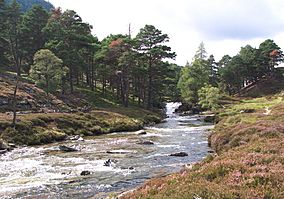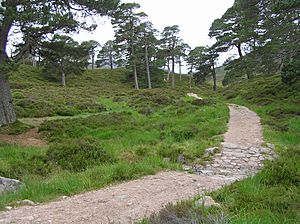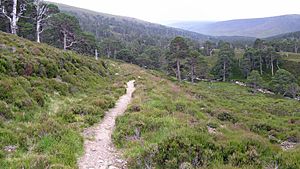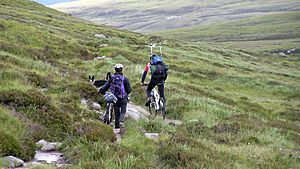Mar Lodge Estate facts for kids
Quick facts for kids Mar Lodge Estate National Nature Reserve |
|
|---|---|
|
IUCN Category II (National Park)
|
|

The River Quoich
|
|
| Location | Aberdeenshire, Scotland |
| Area | 293 km2 (113 sq mi) |
| Designation | NatureScot |
| Established | 2017 |
| Owner | National Trust for Scotland |
| Website | https://www.nts.org.uk/visit/places/mar-lodge-estate |
Mar Lodge Estate is a huge area of wild land in the Scottish Highlands. It's located in Aberdeenshire, Scotland. Since 1995, the National Trust for Scotland (NTS) has owned and looked after it. The main building, Mar Lodge, is about 6.4 kilometers (4 miles) west of the village of Braemar.
This estate is super important for nature. It's considered one of the best places for nature conservation in the British Isles. Mar Lodge Estate covers almost 8% of the huge Cairngorms National Park. That's about 29,340 hectares (72,500 acres)! Because it's so special, much of it is protected. It's a Site of Special Scientific Interest (SSSI), a Special Area of Conservation (SAC), and a Special Protection Area (SPA). Since 2017, the entire estate has been a National Nature Reserve. It's also a "Category II protected area" by the International Union for Conservation of Nature. This means it's a very important national park.
The weather at Mar Lodge Estate can be extreme, especially on the high plateau. Landslides, avalanches, and floods often change the landscape. This creates interesting landforms, like deep valleys and rocky cliffs. The northern part has rounded granite mountains from the Cairngorms. You can also see amazing glacial valleys like the Lairig Ghru. To the southwest, there are more open, rolling hills near the River Geldie. The water from these mountains forms the start of the River Dee.
Mar Lodge Estate is very popular with hill walkers. It has 14 Munros (Scottish mountains over 3,000 feet). Four of Scotland's five highest mountains are here, including Ben Macdui, which is Britain's second-highest mountain. The NTS provides a car park and toilets near the Linn of Dee waterfall. This is the main starting point for exploring the area. You can enjoy outdoor activities like hillwalking, climbing, and wild camping. This is allowed because of Scotland's general right to responsible access to land.
Contents
Discovering Wildlife: Plants and Animals of Mar Lodge Estate
Mar Lodge Estate is home to many different types of plants and animals. You can find parts of the ancient Caledonian pine forest here. There are also areas of heather moorland and juniper bushes. The high Cairngorm plateau is also part of the estate.
Animals and Birds of the Forest and Mountains
The Caledonian pine forest is a special place for many animals. You might spot red squirrels, pine martens, and wood ants. Rare birds like the black grouse, Scottish crossbill, and parrot crossbill also live here. These birds are hard to find in most other parts of Britain.
Higher up, on the Cairngorm plateau, you can find unique birds. These include the dotterel, snow buntings, and ptarmigan. This area also has the largest collection of arctic-alpine flora (plants that grow in cold, high places) in Britain.
Exploring the Buildings and History of Mar Lodge Estate
The buildings on the estate are also very important. There are five listed buildings, including Mar Lodge itself.
Mar Lodge: A Grand Building with a Past
Mar Lodge was built in 1895 by the Duke of Fife. Its ballroom is famous for having 2,435 red deer stag heads on the walls and ceiling! In 1991, a fire badly damaged the lodge, but it was rebuilt quickly. Today, it has been turned into holiday apartments. It still has many grand features from when it was a hunting lodge.
Hunting Lodges and Bothies
Six smaller hunting lodges were built on the estate. These were for hunting parties to stay in, away from the main Mar Lodge. Only one, Derry Lodge, is still standing, though it needs repairs. In 2016, the NTS planned to fix it up. They wanted to turn it into a hostel for walkers and cyclists. Derry Lodge is about 6 kilometers (3.7 miles) from the nearest road. This means you can only reach it by walking or cycling.
The estate also has many old archaeological sites. These are protected as Scheduled Ancient Monuments. In 2006, the Mountain Bothies Association worked with the NTS to improve Corrour Bothy. They added a wood-burning stove and a toilet block for visitors.
A Glimpse into the Past: History of Mar Lodge Estate
Mar Lodge Estate is the largest remaining part of the old Earldom of Mar. In 1715, the 6th Earl of Mar, John "Bobbing John" Erskine, took part in a rebellion. Because of this, the estate was taken away from his family in 1716. This ended the old feudal system of land ownership there.
Later, in the 1730s, a clever businessman named William Duff of Dipple bought the western part of the estate. This became the core of Mar Estate. Over the years, Mar Estate and another large estate called Invercauld gradually bought up smaller pieces of land around them. Eventually, they were the only two big estates left in the Braemar area.
In the 1800s, the estate became more focused on hunting and fishing. New hunting lodges like Derry Lodge were built. The small village of Inverey is the only village that survived the "clearances" on the estate. These were times when people were moved off the land.
In 1889, Alexander William George Duff married the Princess Royal. He became the 1st Duke of Fife. After he died in 1912, his family managed the estate.
During World War II (1942-1944), a Canadian logging group worked on the estate. They cut down trees to provide wood for the war effort.
In 1962, the Swiss Panchaud family bought Mar Lodge Estate. They ran it as a business for sports like hunting. They also turned the Lodge into a hotel. They built vehicle tracks all over the estate, even near the top of Beinn a' Bhùird. They also started building a ski center behind Mar Lodge.
In 1989, a company called Mar Lodge Estate Inc. bought the estate. They focused on sports but also on taking better care of the land. The lodge was damaged by fire in 1991 but was fully repaired by 1993.
The National Trust for Scotland Takes Over
On June 30, 1995, the National Trust for Scotland bought Mar Lodge Estate. This was a huge purchase! They needed a lot of money from private and public groups. A group called the Easter Charitable Trust offered £4.5 million. The Heritage Lottery Fund offered over £10 million. These funds helped buy the estate and set up money for its future care. Scottish Natural Heritage (SNH) also agreed to help manage the estate for 25 years.
There was a lot of talk about who made the big anonymous donation. Many thought it was Prince Charles. But it was later found out that Ann Marie Salvesen, from a shipping family, had quietly donated £4.5 million.
Protecting Mar Lodge: Conservation Efforts
After the National Trust for Scotland bought the estate, they created a plan to protect its wild nature. They wanted to keep the land looking natural and wild.
Helping the Pinewoods Grow Back
A big goal of the NTS is to help the native Caledonian pinewood forest grow back. They want the forest to expand naturally, without fences or planting new trees. To do this, they needed to greatly reduce the number of deer on the estate. When the NTS bought Mar Lodge, there were over 3,500 red deer. They aimed to reduce this to 1,600 by the year 2000.
It was a challenge to reduce the deer numbers. By 2011, the deer population was around 1,700, which was closer to their goal. However, the forest wasn't growing back as quickly as hoped. So, the NTS changed their plan. They divided the estate into two areas: a moorland zone and a regeneration zone. They added some fences to help protect the young trees in the regeneration zone.
Managing Tracks and Paths
The NTS also wanted to make the land feel wilder by removing old vehicle tracks. In 1997, they started removing a track on Beinn a Bhuird. This track had been made with a bulldozer in 1966. The NTS developed new ways to remove the track. They lifted plants, reshaped the land, and replanted the vegetation. This helped the track blend back into the hillside.
However, not all track work was seen as positive. In 2002, another track was rebuilt using new materials. Some people, like scientist Adam Watson, felt this damaged an old, handmade cart track. He said it caused "unnecessary environmental impact."
The NTS also had rules about vehicles and bikes. The money they received to buy the estate came with a condition. It said they should try to stop the use of mechanical or wheeled vehicles. At first, the NTS thought this included bicycles. They put up signs discouraging bikes. But in 2001, they changed their policy. They decided to allow bikes in areas where their own Land Rovers could drive.
Restoring Plantations
When the NTS took over, there were many plantations of trees that looked unnatural. These were often planted in straight lines to provide shelter for deer. The NTS wanted to make these plantations look more natural. They started removing trees that weren't native to the area. They also thinned out trees and softened the edges of the plantations. They removed the fences around these areas to let nature take its course.
However, some of these tree-cutting operations caused problems. In 2012, Adam Watson visited a timber operation near Bridge of Ey. He saw that the machines had damaged the soil. They created deep wheel ruts and caused soil erosion. This meant that silt-filled water was flowing onto the public road and into nearby streams.
Images for kids







